
One of the best ways to get the word out about your brand is to land a search result in a featured snippet.
In this article, we’ll go over how to find snippet opportunities.
What We’ll Cover:
- What Is A Featured Snippet?
- Why Do Featured Snippets Matter?
- How to Review Your Current Snippets
- How to Find Your Competitors’ Snippets
- Secure Featured Snippets with Strategies that Already Work
- Structuring Your Content for Future Opportunities
- FAQs About Featured Snippets
What Is A Featured Snippet?
According to Google, featured snippets are special boxes where the descriptive snippet is shown before the regular search result information. These snippets can also appear within a related questions group (also known as “People Also Ask”).
Sometimes called “Rank 0,” featured snippets are enhanced search results that include a summary of the information that searchers on Google are looking for.
For example, if you run a Google search for “What is a featured snippet,” you will see one in the search results at the top. That snippet will give you the answer to the question.
In contrast, other search results show you a title and a brief description along with the link. That’s it.
Although a snippet will often provide answers, they also include a link. Curious searchers will sometimes click on the link to learn more information about the topic. This is an excellent way to drive traffic to your website.
There are four types of featured snippets:
- Paragraphs – provide definitions and answers for important questions.
- Lists – can be used in a variety of ways, including to identify different products, rank things, or demonstrate the steps of a process.
- Tables – include data for different types of comparisons.
- Videos – popularized by YouTube, these snippets could be anything that your YouTube channel wants to feature.
The most popular type of featured snippet is the paragraph because they can usually respond easily to simple or straightforward questions.
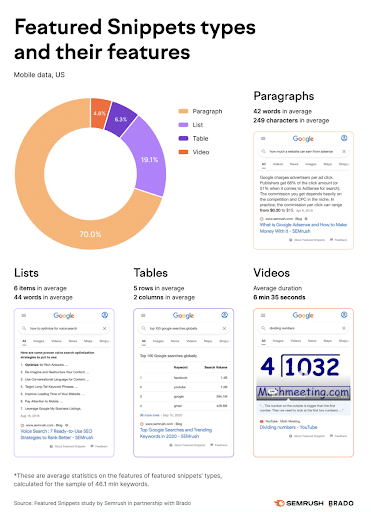
Types of Snippets
Why Featured Snippets Matter
Landing a Featured Snippet could be a major win for your brand. Featured Snippets are among the first things that searchers see and can usually grab their attention pretty quickly.
Additionally, Featured Snippets offer these benefits as well:
- Increase in Credibility – If your information is a Featured Snippet, you must have some authority somewhere! When people see your information front and center, they will know that they can trust you.
- Improves Click-Through Rate (CTR) – Since Featured Snippets usually pop up in response to a user asking a question, chances are that that user is going to be looking for a quick response. When your Featured Snippet provides that response and is easy to click on, you’re going to get their traffic.
- Capitalizes on Voice Technology – Devices such as Amazon Alexa, Apple’s Siri, or Google Assistant often pull the majority of their information from Featured Snippets. So if someone asks it a question that your Featured Snippet can answer, they’re probably going to use you as a resource.
Featured Snippets are a great way for brands to cut through the clutter and get their content front and center, where everyone wants their information to me.
How to Check Your Current Snippets
Before you begin the process of looking for opportunities, you should first understand where you’re at in terms of snippets.
Answer the following question: how often does my site appear in a snippet? To answer this question, you’re going to need to enlist the help of an online tool, like SEMRush.
Once you’ve opened SEMRush, just plug your URL into the search field and check the results. On the left-hand sidebar, you’ll see a menu.
Beneath the “Domain Analytics” section, look for “Organic Research.” Below that, click on “Positions.”
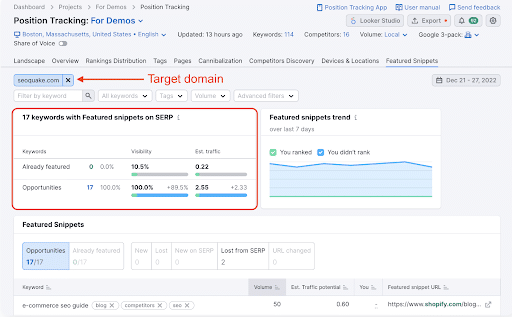
A screenshot of SEMRush’s Dashboard
You’ll see a new screen that gives you information about how often your site appears in the search results. Glance over to the right-hand side of the page and look at the section called “SERP Features.”
Just below that, you’ll see info about how often your site appears in special search engine results.
Take a look at the percentage of your search results that appear in a snippet.
If you’re seeing a very low number there, don’t worry. That’s fairly common.
That doesn’t mean that you don’t want to improve, though.
How to Find Your Competitors’ Featured Snippets
If you’re wondering how to find opportunities, take a look at your competitors.
Now that you know where you stand in terms of how often your site appears in a featured snippet, it’s time to go through that same process for your competitors.
Why? Because you want to beat them. That’s why.
If your competitors are appearing in snippets 1% of the time, then you should make it your goal to appear in them 2% of the time.
That’s how you’ll steal market share away from other businesses in your industry.
The good news is that SEMRush lets you spy on your competitors. Just plug their URLs into the search bar, one at a time, and look at the same report you checked out for your own domain.
Make a note of their stats and quietly say to yourself: “Challenge accepted.”
Also, pay attention to where the competitors’ snippets are coming from. Ask yourself the following questions:
- Are they coming from content on the blog?
- Are they coming from the homepage?
- Are they coming from category pages?
That’s important because you might need to imitate some of their tactics to steal their snippet spots.
Another thing to keep an eye on when performing your competitive research is any markup associated with any current snippets.
If you see that it’s been marked up to include review ratings, photos, etc., you may want to apply the same Schema to your listings to compete on the same playing field.
Beyond that, look at ways you can improve upon the current snippet holder. Going the extra mile will 100% pay off here, so really focus on how you can make the information better or clearer than your competitor.
Secure Featured Snippets with Strategies That Already Work
When looking for opportunities, you should start with the basics – gather all of your keywords that are currently appearing in snippets. You can do this easily by using SEMRush’s Keyword Magic tool.
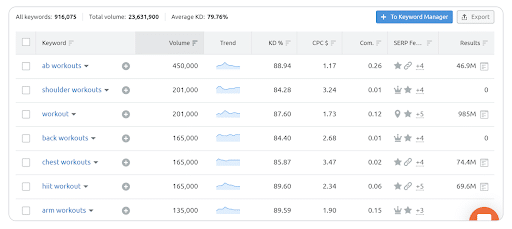
Report in SEMrush
Start by gathering all your keywords that are currently appearing in snippets. Since Google already recognizes you as an authority on those subjects, use that list of keywords as your starting point. It should be fairly easy to grow your rank on terms related to those keywords as well.
Once you have your desired list, export those keywords to a spreadsheet. Then, prepare that spreadsheet for upload to the SEMRush keyword tool.
Once the keywords are uploaded, look at related keywords to find new ones to focus on. Take a look at the stats for each term and select some “low-hanging” fruit, or keywords that don’t have a lot of competition but are still often searched by users.
Keep in mind, though, you don’t need really low competition. If Google already considers you an authority on certain keywords, the algorithm will turn to you when pulling results for related keywords.
Once you’ve gathered a bunch of keyword opportunities, export those to a spreadsheet. Then, it’s time to gather even more keywords.
Using SEMRush to Find Opportunities
Although you’ll uncover some great keyword snippet opportunities when you follow the steps described above, keep in mind that SEMRush has already done quite a bit of the heavy lifting for you.
On the Featured Snippets Report, SEMRush highlights keyword opportunities. You’ll see those when you click the “Opportunities” button at the top of the table.
Export those keywords to a spreadsheet as well. You might (and probably will) have some crossover between the two spreadsheets, but that’s okay. You’d rather have keywords listed twice than not at all.
Once you’ve got all your keywords in spreadsheets, it’s time to get busy.
Go After Your Competitor’s Placements
Knowledge is power, right?
Once you’ve carefully analyzed your keywords that are ranking for snippets, you can plug those keywords into Google to see who is claiming the spot for each keyword.
These will likely belong to some of the competitors you uncovered in your competitor research phase, and you’ll notice the same things – their content structure, where it’s coming from, and what markup they’re using.
Then, look back at your own content surrounding that particular keyword and compare it to the competition. Is it structured in the same way? Does it clearly answer the question the user would be asking?
Beyond that, look at ways you can improve upon the current snippet holder. Going the extra mile will 100% pay off here, so really focus on how you can make the information better or clearer than your competitor.
Once you’ve made your edits and feel confident with your content, these changes will encourage Google to reconsider your site for a snippet opportunity.
This will give Google the opportunity to quickly find your (better) piece of content and rank it higher. If you don’t get the snippet spot the first time, revisit your content, tweak it a little, and ask Google to recrawl.
How to Structure Your Content to Take Advantage of Opportunities
Of course, theft isn’t the only way to gain a snippet on Google. It makes even more sense to structure your own content in a way that makes it ideal for position 0.
After all, if you want a shot at earning the coveted snippet box, you have to format your content in a way that appeals to Google’s algorithm. This mainly means writing clear, concise, and factual content. Make it clear that your content can answer this particular Featured Snippet question.
There are also other things to consider when writing your content in the hopes of landing a Featured Snippet. For example, try to create content that adheres to the following:
- Answer questions revolving around your target keyword
- These answers should be brief or in a list format
- Questions should be in H2 (your subheadings)
- The web page must already be ranking on page one of the SERPs
That doesn’t necessarily mean you have to redo each page.
Cleaning up your content and delivering it in simple, concise language will go a long way. Remember, Google’s goal in creating a snippet is to provide quick, easy answers that best fit a user’s exact search query.
So think simply.
This applies to your content across the board – page titles, H1 and H2 tags, and your body text.
For example, if you have an article titled “How to Conduct a Link Audit That Gets Maximum Results,” try switching it up to simply “How to Conduct a Link Audit.”
It will more closely mirror what users are searching for and may give your content the boost it needs to land position 0. The same principle goes for the H2s throughout your text.
When your content is structured in a way that helps Google crawl it, the more likely it will be to gain traction and find its way to a Featured Snippet. Keep in mind that Google prefers recent and updated content so don’t hesitate to update your old articles and blogs.
Beyond that, here’s a trick or two to help you format your content for featured snippets opportunities.
How the Jeopardy Principle Applies
Those keywords in the list might not be the exact keywords that you’ll rank for. Sometimes you’ll add some words to them.
One of the best ways to do that is by following the Jeopardy Principle. Put your keywords in the form of a question.
Why? Because it’s often the case that people type questions into the search bar on Google.
Let’s say you’re running a business that offers training courses in the Adobe suite of products. You’re trying to attract business with articles that offer mini-tutorials on how to accomplish certain tasks in Adobe software.
After doing some research on SEMRush, you discover that “keyframe” is a search term that gives you an opportunity to land a snippet. But instead of just writing an article about keyframes, you decide instead to write an article entitled “What is a keyframe?”
That’s the Jeopardy Principle in action. You put your keyword in the form of a question.
Of course, your article will also answer that question. Google might include your answer in a snippet.
In fact, if you run a Google search for “what is a keyframe” right now, you’ll see that this snippet comes from Wikipedia.
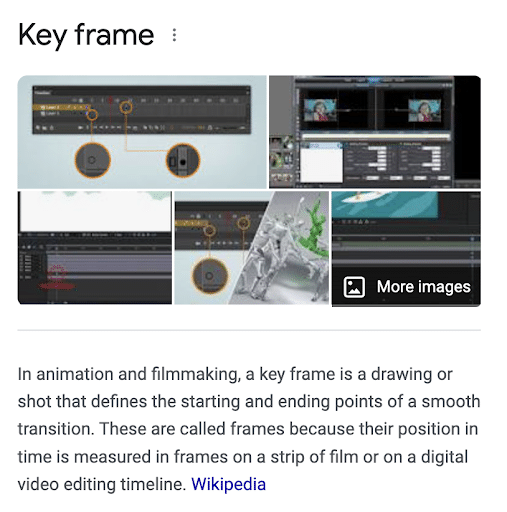
Example of Featured Snippet
That’s just one example. Think about all the ways that people can ask questions related to your keywords.
One way to do that is by visiting Answer the Public. Go to that site and plug in the word “keyframe.” Then, search for questions.
You’ll get 86 questions, 72 prepositions, and 54 comparisons. Use each one of them as inspiration for featured snippets opportunities and produce content that both asks and answers the questions you’ve created.
When answering questions, it’s usually a good idea to do so with bulleted lists. That’s because Google loves to put lists in snippets.
In the Digital Age where instant gratification is highly sought after, people are much more likely to comprehend a brief list of key points rather than several paragraphs of long text. Google has optimized its results accordingly.
The question itself should use the H2 tag. That’s the subheader one level below the title itself. Titles usually use the H1 tag.
Why Word Choice Matters for Opportunities
We know that questions perform exceptionally well when it comes to earning a spot. But how you phrase those questions plays a big part as well.
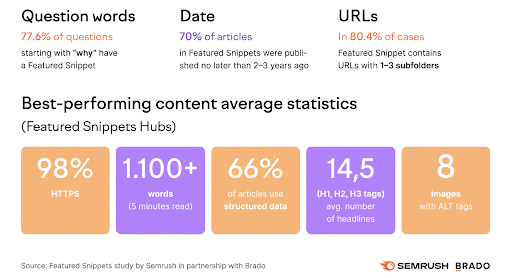
Featured Snippets Statistics from SEMRush
A recent study into the intricacies of features snippet winners revealed the following:
- Questions are great
- Almost all question words (Who, what, can, should, etc.) performed well in summary snippets
- “How” and “have” performed best
- “Which” performed best in snippet tables
- Prepositions (for, like, to, with, without) earned the most lists
- Comparison words (pricing, vs., etc.) earned the most tables
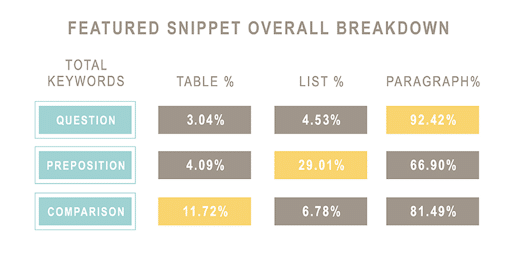
Featured Snippet Breakdown from Moz
It’s important to note that while questions are undeniably critical, they’re not the only way to earn a snippet, especially if your content is better suited to list or table form.
Why Long Tail Keywords Are Important
Speaking of varying your content, there might be other ways you can use the keywords as well.
Let’s stick with “keyframe” for a bit longer.
If you run a Google search for “definition of keyframe” instead of “what is a keyframe,” you’ll see something different in the snippet.
It’s an excerpt from a Wikipedia article.
It is not easy to beat Wikipedia on a keyword like that. However, you might find that some of your competitors are ranking #0 for variations of search terms.
You could beat them.
Look at other “tails,” or additional words, that you can add to your keywords. A tool like LongTailPro will come in handy for that purpose.

Use LongTail Pro to Find Keywords
Just plug your “base” keyword into LongTailPro and it will show you a report of long-tail keyword opportunities. Some of those will land you in a snippet.
Keep in mind: you won’t get a whole lot of traffic when you optimize your site for long tail keywords. However, you will get targeted traffic. Sometimes, that’s more valuable and can lead to higher conversion rates in the long run.
Also, if you optimize your blog posts for dozens (or hundreds) of long-tail keywords, then you will get quite a bit of traffic. That’s a great strategy as well.
How to Optimize For Base Keywords
Once you’ve optimized your site for questions and long tail variations of the keywords you found in SEMRush, it’s time to put the base keywords to work.
One of the best ways to do that is by creating a different piece of content that’s optimized for each one of the keywords.
For example, if you want to rank for “keyframe,” write an article with the keyword in the title, such as The 7 Best Ways to Use the Keyframe Feature in Adobe Premiere Pro.
As you write your article, sprinkle the word “keyframe” (sprinkle! Don’t keyword stuff!) the word throughout the content. While you probably won’t be able to beat Wikipedia for position 0 for the word “keyframe”, you have a good shot of getting a snippet from the long-tail keyword “how to use keyframe in Premiere Pro.”
Once you’re done with that article, repeat the process for each of your desired keywords. This is a good attempt to boost your chances of securing a coveted snippet spot.
Average Snippet Lengths
You would think that identifying your opportunities, forming a keyword list and deciding how best to format your content would be enough.
However, when it comes to fighting for the coveted featured snippet, you don’t want to leave anything to chance – right down to the exact length of your content.
Here’s a rundown of the optimal lengths for each content type, courtesy of Moz:
- Paragraph – The go-to length here is 40-50 words, roughly 300 characters. Remember, short and sweet wins the race when it comes to position 0.
- List – The average number is 4, but naturally, we don’t want to be average. While the snippet will cut off at 8 list items, it’s a good practice to try to include as many list items as possible. When there are more than 8, Google will display a “More items” link and prompt users to click through.
- Tables – The most important element here is the format: if you’re trying to win a snippet table, make sure it’s in table form. Google will display a max of three columns and nine rows, but don’t let that limit you. If more rows are on your site, users will have the opportunity to see and click through.
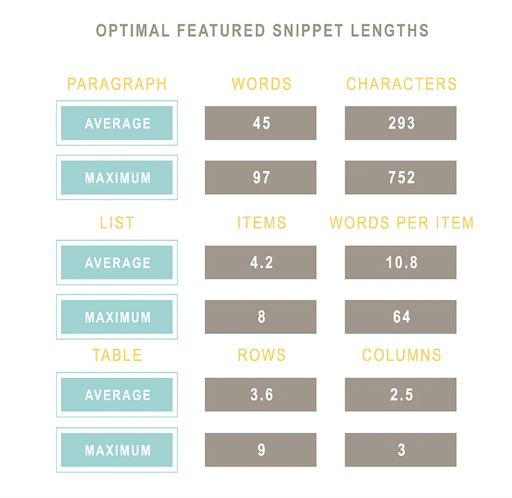
Optimal Snippet Lengths, Courtesy of Moz
Featured Snippet FAQs
1. Is there anything that won’t show up in a featured snippet box?
Yes. Images, videos, local, and shopping search queries will not appear in answer boxes on Google.
2. Is there any specific website coding that can help my content land a featured snippet spot?
No. As of now, there is no specific markup or code that can optimize your website content for a feature in a Google snippet. As previously mentioned, structured markup (Schema) has its own benefits, but it won’t guarantee a snippet spot.
3. Is Google the only search engine that has featured snippets?
No. Bing does this as well and may even give you different results than Google.
Wrapping It Up Featured Snippets Opportunities
Those are some ways that you can optimize your site for featured snippets. As is the case with many other aspects of SEO, it all starts with keyword research. Then, you need to “massage” those keywords to create some snippet opportunities. Finally, use the keywords themselves in some of your best content.